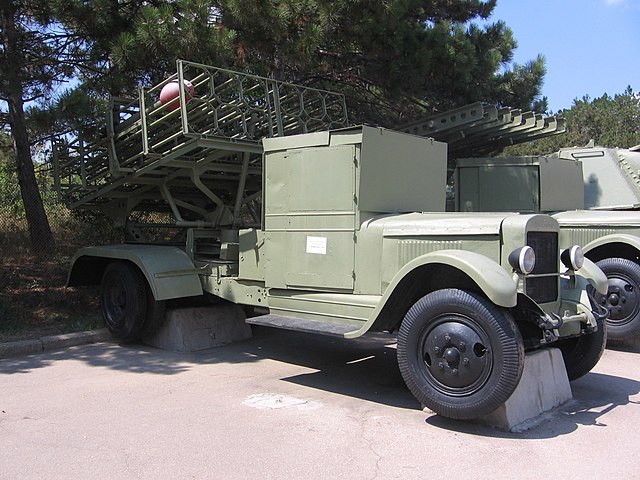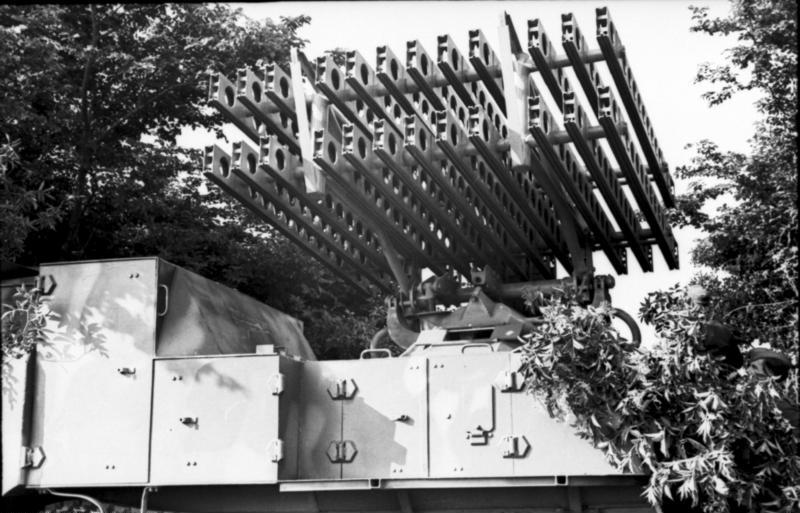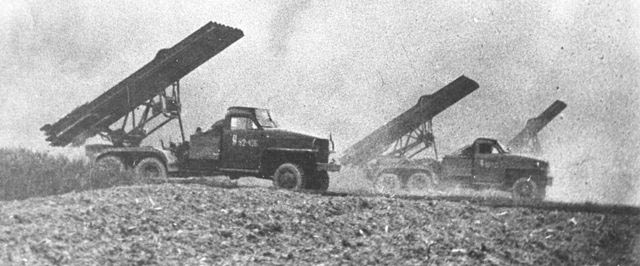BM-13 Katyusha (1940)
 Rocket-Launcher truck
Rocket-Launcher truck
Development of Rocket Artillery in Soviet service
 Katyuscha based ZIS-6 preserved at Nizhni Novgorod.
Katyuscha based ZIS-6 preserved at Nizhni Novgorod.
The use of "rockets" (raketa in Russian) is a huge topic that would cover hundreds of pages if seen in detail. The art of rocketry was born practically at the same time as the development gunpowder in Asia, with Korea seemingly the most adept in its use, notably with the world's first battlefield rocket launcher, the Huacha. This was a very innacurate weapon which effect was mostly psychological, especially against poorly trained troops and mounted animals like horses. The rocket was still use in some rare cases by Western armies in the XVII-XIXth centuries. In WWI, it was mostly used by aircraft to hunt down observation balloons and airships, tipped with incendiary warheads. Again it returned to the marging and experiments in the interwar, and notably tested by engineers or amateurs in Germany and USSR but never considered seriously enough to motivate the creation of a specialized branch of the artillery.
Still, in the 1920s, USSR reconsidered this as a weapon and was ready to proceed to evaluation given the advances made on rocket fuel notably. The bulk of the studies were made at the time by the Reactive Scientific Research Institute. Initial development started with the solid propellant, with Nikolai Tikhomirov in charge of the Soviet Gas Dynamics Laboratory. The first test was performed by March 1928, with a 1,300 meters distance, and soon these mass-produced early rockets were for JATO (Assisted Aicraft Take-Off) most often when overloaded. RS-82 and RS-132 models (the initials stands for "Reaktivnyy Snaryad" or "rocket-powered shell" by the early 1930s under the direction of Georgy Langemak. These smaller, simpler aircraft-fired rockets were intended for ground support.
 Loading the BM-13-16: The M-13 needs to be well inserted in the rails.
Loading the BM-13-16: The M-13 needs to be well inserted in the rails.
June 1938 saw the creation of the Reactive Scientific Research Institute, starting producing launcher prototypes and created ultimately the modified 132 mm (5.2 in) M-132 rockets. At first two axles ZIS-5 trucks were tested with simple ramps mounted in broadsides, but they proved unstable. V.N. Galkovskiy then proposed longitudinal launch rails with some base traverse. In August 1939, these attemps succeeded in creating the BM-13 (BM for "boyevaya mashina" or "combat vehicle" with rails created to carry M-13 rockets.
First large-scale firing of rockets for comparative purposes (range, accuracy, explosive power...) were made by fall 1938, with 233 fired. Grouped fire manage to completely destroy a large target some 5,500 metres (3.4 mi) away, and artillery officers, intended to receive the new systems, however, were not impressed. It seems already the system was known "Katyusha" from a very common Russian girl name, but it was more complicated (see later). The greatest point of contention was that 50 minutes were needed before firing the 24 rounds whereas a conventional howitzer co do 95-150 rounds in the meantime. Testings went on in 1940, with the BM-13-16 (Launch rails for sixteen rockets) was found the best of all these systems, and greenlight for mass production. However at the time of Operation Barabrossa in June 1941, only forty launchers (without base) had been delivered. So they counted for naught in the initial phase.
About the name, Initially, secrecy had them named the "Kostikov guns" (after the head of the RNII institute) and "Guards Mortars" as only guard units fielded them at the start. The name "BM-13" on appeared in secret documents from 1942, staying classified until 1945. The "K" was applied from the Voronezh Komintern Factory as only clue, so Red Army troops found "Katyusha" in the popular Mikhail Isakovsky's song, a girl longing for her absent beloved at war, a theme reminiscent of "Lili Marlene". Katyusha (Katherine) was often transformed into "Katya" rather used affectionately. Still on the receving axis end, this was "Stalinorgel" (Stalin's organs) and it genuinly terrified German troops. The Finnish called them "Stalinin urut" and Hungarians "Sztálinorgona". The larger BM-31 launcher became Andryusha (diminutive of "Andrew").
The BM-13 rocket system
 A rather overloaded ZIS-5 BM-13-16 preserved.
A rather overloaded ZIS-5 BM-13-16 preserved.
If the BM-13-16 was the first introduced, many more were also produced, with only changes on the general configuration for the ramps, which were standardized in three lenght with the same dimensions, and to save metal, holed along. The fixtures to held them together were made with simple beams and profiles and the initial mail launh beams were shaped in a "T" or like a rail tread, with guides on both sides. The rockets, which had a build-in quills, were inserted manually, which was the longest part of the process.
The elements were also, given the lenght of the structure, mounted on frames using pre-assembled tubes ending with welded bolting heads, also standardized with clear marking in order to be delivered as kits for easy conversions on the battlefield.
All this process started after production was relocated in the Urals and restarted, in mid-1942 production rapidly ramped up to reach several thousands "kits" by the winter 1942-43. At Stalingrad, the system was used in mass for the first time. Depending on the target distance, more or les long ramps were used. However the greatest standard became rapidly the 13-12, by far the most common and with the longest range.
 BM-13N preserved in Moskow, note the cabin's protection panels, doubling as light armour with sight slits; They all could be folded on the roof.
BM-13N preserved in Moskow, note the cabin's protection panels, doubling as light armour with sight slits; They all could be folded on the roof.
Manufactured in the Voronezh excavator factory (rockets and mounts), two BM-13 were combat-tested in July 1941 and construction was rationalized constantly during the war for easier manufacture, allowed greater volley repetition going over time from five minutes to fifteen seconds. 300 BM-13 from Voronezh were used for the Moskow winter 1941 counter-attack, their first mass use, which was successful as the Germans never encountered such firepower. The psychological terror they inspired by their noise as part of the drama. It was some payback for the Stuka attacks all along the summer.
The simple design counted on very standardized racks of parallel rails on folding frame, helping to raise the rails to launch position, with the base provided a truning table for full traverse, and later, a system of securization and folding stabilization feets.
The M-13 rocket

The M-13 rocket of the BM-13 system was 80 cm (2 ft 7 in) long, 13.2 cm (5.2 in) in diameter and weighed 42 kg (93 lb) for a 4.9 kg (11 lb) warhead, range was 8,740 m (9,560 yd). The system obviously lacked accuracy but was excellent for saturation fire, better than any artillery battery by the sudden, massive rain of warheads on a concentrated perimeter. The explosive warhead was equivalent to a marine shell of that caliber, although some Russian self-propelled guns such as the SU/ISU-152 had larger calibers. A direct impact on any tank was also shattering. It evolved frmom the earlier, smaller M-8, 82mm,0.64 kg (1.4 lb) model that can reach 5,900 m (6,500 yd) and light enough to be mounted on Jeeps or light tanks. Later, the M13 was improved with a longer barrel and charge as the M-13DD for a range of 11,800 m (12,900 yd). The final M-13UK was safer, and easier to reload, still with a range of 7,900 m (8,600 yd). Later were developed the M-20, 132 mm but longer and 18.4 kg (41 lb), for a range of 5,050 m (5,520 yd), the M-30 of 300 mm (12-inches, battleship caliber) weighting 28.9 kg (64 lb) but only 2,800 m (3,100 yd). The propeller tube was indeed smaller than the bulbous charge for easier manutention. It was further developed into the M-31, range 4,325 m (4,730 yd) and the M-31UK, range 4,000 m (4,400 yd), which all had the same wearhead but minor perforlances differences.
The BM-13 rocket system
The favourite platform became by far the ZIS-6 truck with its 2x8 chassis, strong enough for the largest configuration, with some reaching 72 rockets, like the BM-8-72 only carried by rail carriages and
armoured trains. The largest, truck-based, was the BM-8-48 (48 rockets) carried by the ZIS-6 and Studebaker US6, espcially the latter in 1945 which superseded the weaker, obsolete ZIS-6 and was used for long postwar. It was soon deslined into a multude of platforms, not only trucks, see below:
Main Variants
 BM-31-12 on a ZIS-12 chassis (the 300 mm 12-inches model). This was not a popular version, the lend-lease, then home-produced US-6 was far more suitable. The "armour plates" on the cabin's windows were not for bullet protection, but protect the crew inside from the massive blast.
BM-31-12 on a ZIS-12 chassis (the 300 mm 12-inches model). This was not a popular version, the lend-lease, then home-produced US-6 was far more suitable. The "armour plates" on the cabin's windows were not for bullet protection, but protect the crew inside from the massive blast.
- BM-8-36/ZIS-5 or ZIS-6 truck
- BM-8-40: towed trailer for ZIS-5/ZIS-6 truck
- BM-8-48/ZIS-6 truck
- BM-13-12/ZIS-6 truck
- BM-13-12/ZIS-5 truck
- BM-13-12/ZIS-5V truck
- BM-13-12/GAZ-AA (Towed trailer only)
- BM-13N: Mounted on the Studebaker US6 2½-ton 6×6 truck
- BM-13-16: mounted on the Austin K7, Intl. M-5-5-318, Fordson WOT8, Marmon HH6-COE4, Chevy G-7117, GMC CCKW-352M-13
- BM-13-12/ZIS-151 (postwar)
- BM-20-6 Towed Trailer
- BM-30-4 Towed Trailer
- BM-31-4 Towed Trailer
- BM-31-12: Mounted on the Studebaker US6 U3 truck
Rarer Variants
- BM-8: Improvized basic mount
- BM-8-6: Light Towed trailer
- BM-8-8: Mounted on lend-lease Willys MB jeep
- BM-8-24: Mounted on T-40 chassis
- BM-13-12/STZ-5
There were also variants carried in BM-8-72 Armored train car, Pr. 1125 River boat, Towed sledge, Towed trailer, and even individual backpack or "mountain Katyusha"...
 The German 8 cm Raketen-Vielfachwerfer was based on the Katyusha, here to protect the Riva Bella Atlantic wall HQ on the coast in Northern France, 30 May 1944. This was a modified half-track based on the SOMUA MCG.
The German 8 cm Raketen-Vielfachwerfer was based on the Katyusha, here to protect the Riva Bella Atlantic wall HQ on the coast in Northern France, 30 May 1944. This was a modified half-track based on the SOMUA MCG.
Captured Katyushas by Germany were reused in various ways, but soon they found the Russian system crude and instead anufactured the 8 cm Raketen-Vielfachwerfer, still based on the Katyusha. It was used on many platforms in 1944-45. Romania's Mareșal tank destroyer prototype by late 1942 was declined into a Katyusha rocket launcher variant, tested by the summer of 1943, but this was abandoned.
Combat deployment
By July 14, 1941, a first experimental battery of seven launchers was used for the battle at Rudnya in Smolensk Oblast (Captain Ivan Flyorov) and completely shattered and dispersed a concentration of spotted German troops, tanks, wheeled armored vehicles and trucks gathered in a marketplace. Never accustomed to such firepower and its effect, the whole unit hastily retreat from town, completely panicked. At first only Guards mortar batteries were created, to support infantry divisions, four launchers each and kept under NKVD control to keep the secrecy.
On August 8, 1941, Stalin ordered the formation of eight special Guards mortar regiments to be used by the Reserve of the Supreme High Command, each regiment composed of three battalions subdivised in three batteries for 36 BM-13/BM-8. Guards mortar battalions had 12 launchers in three batteries, four each and by the end of 1941, eight regiments, 35 independent battalions, two independent batteries were deployed, so 554 launchers. They proved instrumental in the counter-offensive of moskow.
By June 1942, heavy Guards mortar battalions received the new M-30 static rocket launch frames, 96 launchers in three batteries. They were long to deploy, but their effects before an offensive war properly terrifying. By July 1942, a battalion of BM-13s was added to each tank corps and by 1944, BM-31s were deployed in motorized heavy Guards mortar battalions, each having 48 launcher vehicles. In 1943, Guards mortar brigades, later divisions, received static launchers. Fall 1942 already there were 57 regiments in service plus many independent battalions for 216 batteries, composed as follows:
-21% BM-8 light launchers
-56% BM-13
-23% M-30 heavy launchers.
After initial success in june for the first battery, mass production was ordered in July, with the development of new models. Unlike tanks, aircraft or even artillery pieces and more like the mortar, the system was quite inexpensive and production was soon extended to more light industrial installations with simple equipment so by the end of 1942, 3,237 Katyusha launchers were delivered, and 10,000 by the end of the war, in all forms. This means millions of rockets, mostlt of the M13 and M30 types. This was enough to have 518 batteries in service in 1945, ranging from 4 to 12 vehicles.
Truck-mounted Katyushas were by far the most popular and common to compose these batteries, with the ZIS-6 6×4 trucks preferred at first, and two-axle ZIS-5 and ZIS-5V, with more often reduced launchers. In 1941 for extra mobility in winter, they were also mounted on STZ-5 artillery tractors but only one or two batteries were created. Some were even mounted on recovered or surplus
KV tank chassis, giving birth to the KV-1K, but it failed to do some impression.
With mounting lend-lease deliveries of British, Canadian and U.S. trucks, more were converted for this use. By elimination the one preferred in 1943 and praised above all else, was the Studebaker US6 2½-ton 6×6 truck which became the Katyusha standard mounting as BM-13N (The"N" stands for "normalizovanniy" or "standardized") with 1,800 manufactured by in 1945, and post-war the legacy went on on the closely based
ZIS-151 truck.
 Offensive on Berlin: A battery of BM-13Ns (Studebaker US6) firing in concert.
Offensive on Berlin: A battery of BM-13Ns (Studebaker US6) firing in concert.
A battery of BM-13-16 launchers included four firing vehicles, two reload trucks and two technical support trucks. Eacch vehicle operate with a crew of six, with two seated in the cabin and two on the mounting, the others with rockets in the supply trucks. Reloading ranged at first to 3–4 minutes so to avoid counter-battery fire, the trucks quickly retreated to another position 10 km away to reload. Three batteries for a company (called "divize"), three made a separate regiment inside a full division, with guards units at corps level.
 B13N operating on the Yugoslav Front
B13N operating on the Yugoslav Front
The initial massive use was in 1942, starting by December 1941 counter-offensive at Moskow. Uusually batteries fired in 7–10 seconds, but they together send to a 400,000-square-metre (4,300,000 sq ft) target area some 4.35 tons of high explosives. This was equivalent to a battery of 72 howitzers furing in concert. With the right support, extra loaders and suply trucks, skilled crews could relaunch in the matter of minutes, and with a semi-automatic reloading system at the end of the war, a mere 15 seconds. It made impossible any counterbattery fire. In general, these were deployed in very large numbers for the surprise and shock effect. It became soon one of the wehrmacht's infantry worst encounter.
That would take too long to detail all the campaigns were these batteries were deployed, but by 1943, virtually all offensives started with a Katusha barrage, completed by a rapid advance, the artillery being growingly used to mop up pockets, and as complement, to keep the infantry head down during the progressing attack. The largest mass use was during Operation Bagrations, the East Prussia offensive, and the Battle of Berlin where the massive M30 were used to flatten entire blockouses. When caught under fire by these battleship-size protectiles, it was not rare for tanks to be tossed over like toys.
But the end of WW2 did not meant the end of this weapon system, far from it: Weurher it was based on the ZIL-151 truck or other, more modern platforms, the Katyusha soldiered on under many flags and many regions of the world, seeing service in the First Indochina War, Korean and Vietnam Wars, Cambodian–Vietnamese War, Yom Kippur War, South African Border War, Ogaden War, Iran–Iraq War, Uganda–Tanzania War, 2006 Lebanon War, First Libyan Civil War, Syrian civil war, War in Iraq (2013–2017), Yemeni civil war (2014–present) and Saudi Arabian–led intervention in Yemen. They were so ingrained in the Soviet command in the cold war, that they premeated into all supported countries around the world. The West took notice already in WW2 anbd developed its own systems, the last of which is the M270 vehicle shared as a NATO standard.

The cold war Soviet doctrine led to develop further the concept, with waves of new models, under the generic name of multiple rocket launchers (MRL), with the adoption of the 140 mm BM-14 and 240 mm BM-24. Then appeared the legendary BM-21 Grad launcher and at the end of the top line, the massive BM-27 Uragan. Today they fired far more impressive rockets, using bomblet submunitions, or remotely mining the terrain, of more advanced chemical warheads. Unlike modern artillery that can fire a rapid volley at various parabolic trajectories to erach a single point at the same time, this is only possible within a battery, each vehicle adopting a different fire angle.

The historical significance over time was raised in Russia at the same level as the AK-47 Kalashikov, and by decree of the President of the Soviet Union Mikhail Gorbachev in 21, 1991n I. T. Kleymenov, G. E. Langemak, V. N. Luzhin, B. S. Petropavlovsky, B. M. Slonimer and N. I. Tikhomirov were all posthumously awarded title of the Hero of Socialist Labour.
Sources/Read More
maquetland.com, review of platform trucks and tractors
On panzerserra.blogspot.com
Katyusha_rocket_launcher
/8-cm-Raketen-Vielfachwerfer
Video